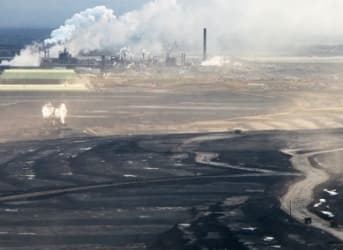While Congress and the White House continue to wrangle over the Keystone XL pipeline extension, the oil industry is taking matters into its own hands.
Markets are primed for an influx of Canadian crude oil, but with pipeline transport off the table for the foreseeable future, producers have built alternative modes to meet the demand. The problem is, recent disasters have soured legislators and environmentalists on road and rail for moving oil.
Alongside political uncertainties are other wild cards like extreme weather and the unknowns that arise from an emerging logistics infrastructure, which can all impact the flow of goods. That makes the proposition of a non-pipeline solution particularly thorny. How should supply chain decision makers position to connect with premium energy markets, manage the attendant risks, while also addressing the strong likelihood of an increased regulatory burden?
Related: Recent “Bomb Trains” Expose Regulatory Failures
From the source of the commodity to the end consumer, the ability to track Canadian oil assets in real-time is set to become more important than ever.
Boom Times For Oil Producers
Production from Canada's oil sands is on the rise, with output expected to nearly double by 2030 to 6.7 million barrels per day. That accounts for about 98% of the country's oil reserves.
Primary market opportunities exist in both Canada and the US, where replacements for offshore imports are desired. Getting the oil to premium and secondary markets however is another matter.
Considering the gooey consistency of Canada's pure bitumen, rail makes sense as the main pipeline alternative. Rail transport doesn’t require dilution prior to shipping, as it does in pipeline transport; so shipping bitumen in its pure form would require fewer barrels. That creates an incremental netback on rail transport of about $6 per barrel, compared to pipeline processing.
Related: Mystery Of The Adviser Who Turned Obama Against Keystone XL
Recent train derailments, however, have attracted public outcry in both countries for tighter controls. That means more regulation is likely, with stiffer compliance for all parties participating in the oil supply chain.
Despite those concerns, the Keystone delay has spurred producers to start shipping Canadian crude by truck, rail and barge. TransCanada, a major energy company based in Calgary has plans to build rail terminals in Alberta and Oklahoma. Exxon Mobil is also planning a new Canadian rail terminal, set for operation this year at a cost of about $250 million. Its completion would accommodate shipments of nearly 100,000 barrels per day.
How The Industry Should Respond
With Canadian crude assets traversing a complex, closely regulated and shifting supply chain, the question of how to effectively manage the risks inevitably pops up. Any process based on spreadsheets won’t be up to the task. They can’t keep up with the moment-to-moment churn of data required to manage activity and make good decisions.
Related: Obama Called Out On Keystone Lies
How much inventory is at risk, where energy assets stand at any given time and the associated capital commitments, all need to traceable down to the carload -- this is literally where the rubber meets the road. Unless systems and processes embrace the real-time, buy-sell-trade environment in oil, you will be hard pressed to react quickly enough when the inherent risks of Canadian crude positions raise their head.
Oil producers and energy traders need to build a robust capability that can handle all that risk data efficiently. That means integration of all the necessary partner and reporting data points. Maps, schematics, and trending data need to be presented graphically, with quick summaries of all active positions, assets and related histories. Given the shift to mobile working and BYOD, all the better if information can be accessed across the full range of devices and operating systems we use to conduct business.
Even with the recent market unrest, America’s appetite for energy is not diminishing. As supply lines for Canadian crude stretch across modalities, borders, time zones, weather patterns, regulatory regimes and market conditions, the ability to monitor assets from the wellhead to the marketplace is critical. Successful oil supply chain risk management will help managers capture the details of every Canadian crude purchase down to the penny, from the front office to the back.
By Mark A. Hill
More Top Reads From Oilprice.com:
- Despite The Risks Oil Shipments By Rail Have To Continue
- How Obama Could Turn The Keystone Debate To His Advantage
- North American Energy Integration Could Bring The Planet To Its Knees



















The Keystone XL is 88% complete. The Canadian section is the only section not started. Even so Canadian oil is already flowing through the Keystone pipeline via other pipelines built long ago. The problem is that Canada is currently producing more oil than the new Keystone pipeline and the downstream refiners can handle. So what are they doing with the oil? Of course they're building storage tanks to hold the oil. Meanwhile the worldwide demand for oil is down and production is up. Republican economics in the works!
Keystone Pipeline Status.
Phase 1: 3456 miles complete.
Phase 2: 291 miles complete.
Phase 3a: 435 miles complete.
Phase 3b: 47 miles under construction.
Phase 4: 526 miles The Canadian section of the Keystone Pipeline (Proposed).
Total: 4755 miles.
Is that anything new? And who is going to talk about their proprietary business processes?
Tell us something we don't know like how and where bitumin is currently shipped. Then draw on your expertise to talk about future changes. That's what I am interested in.